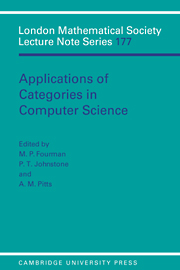 Applications of Categories in Computer Science
Applications of Categories in Computer Science Book contents
- Frontmatter
- Contents
- Preface
- Miscellaneous Frontmatter
- Computational comonads and intensional semantics
- Weakly distributive categories
- Sequentiality and full abstraction
- Remarks on algebraically compact categories
- Dinaturality for free
- Simply typed and untyped lambda calculus revisited
- Modelling reduction in confluent categories
- On clubs and data-type constructors
- Penrose diagrams and 2-dimensional rewriting
- Strong monads, algebras and fixed points
- Semantics of local variables
- Using fibrations to understand subtypes
- Reasoning about sequential functions via logical relations
- I-categories and duality
- Geometric theories and databases
- Partial products, bagdomains and hyperlocal toposes
On clubs and data-type constructors
Published online by Cambridge University Press: 24 September 2009
- Frontmatter
- Contents
- Preface
- Miscellaneous Frontmatter
- Computational comonads and intensional semantics
- Weakly distributive categories
- Sequentiality and full abstraction
- Remarks on algebraically compact categories
- Dinaturality for free
- Simply typed and untyped lambda calculus revisited
- Modelling reduction in confluent categories
- On clubs and data-type constructors
- Penrose diagrams and 2-dimensional rewriting
- Strong monads, algebras and fixed points
- Semantics of local variables
- Using fibrations to understand subtypes
- Reasoning about sequential functions via logical relations
- I-categories and duality
- Geometric theories and databases
- Partial products, bagdomains and hyperlocal toposes
Summary
Introduction
The diagrams for symmetric monoidal closed categories proved commutative by Mac Lane and the author in [19] were diagrams of (generalized) natural transformations. In order to understand the connexion between these results and free models for the structure, the author introduced in [13] and [14] the notion of club, which was further developed in [15] and applied later to other coherence problems in [16] and elsewhere.
The club idea seemed to apply to several diverse kinds of structure on a category, but still to only a restricted number of kinds. In an attempt to understand its natural limits, the author worked out a general notion of “club”, as a monad with certain properties, not necessarily on Cat now, but on any category with finite limits. A brief account of this was included in the 1978 Seminar Report [17], but was never published; the author doubted that there were enough examples to make it of general interest.
During 1990 and 1991, however, we were fortunate to have with our research team at Sydney Robin Cockett, who was engaged in applying category theory to computer science. In lectures to our seminar he called attention to certain kinds of monads involved with data types, which have special properties : he was calling them shape monads, but in fact they are precisely examples of clubs in the abstract sense above.
In these circumstances it seems appropriate to set down those old ideas after all, and to complete them in various ways, in particular as regards enriched monads.
- Type
- Chapter
- Information
- Applications of Categories in Computer ScienceProceedings of the London Mathematical Society Symposium, Durham 1991, pp. 163 - 190Publisher: Cambridge University PressPrint publication year: 1992
- 10
- Cited by


